Online Workshop: Project B (August 2012)
- Chuckwagon
- Veteran

- Posts: 4494
- Joined: Tue Apr 06, 2010 04:51
- Location: Rocky Mountains
Snagman/Chuckwagon-My Csabai is now down to 580g from the green weight of 878g, 66% of original or a loss of approx 33% of the green wght.
My question is regarding the drying period, the product has been hanging in the fridge for 3 days since the final smoke, which leaves about 2 1/2 weeks additional drying. Is there a % of weight drop that would indicate the sausage is ready or should I just continue to let it dry? I know many of the dried products are let dry until consumed but I am curious if there is an ideal for the Csabai--
Thanks
Pat
My question is regarding the drying period, the product has been hanging in the fridge for 3 days since the final smoke, which leaves about 2 1/2 weeks additional drying. Is there a % of weight drop that would indicate the sausage is ready or should I just continue to let it dry? I know many of the dried products are let dry until consumed but I am curious if there is an ideal for the Csabai--
Thanks
Pat
Hi Pat.
Before they can answer, I can do it too.
Congratulation, your sausages are ready to eat. If some are more dry than others, start with the driest one. Because you had them in the fridge, they dried much faster then would be "normal". So start eating them right now. Let the rest dry, as long as you want them, that way you can compare them, to know how you like them best.
*******Most likely the sausage have a dryer ring outside, than inside, because it didn't dry evenly.
Could you make us a picture from cross section ?
Joe.
Before they can answer, I can do it too.
Congratulation, your sausages are ready to eat. If some are more dry than others, start with the driest one. Because you had them in the fridge, they dried much faster then would be "normal". So start eating them right now. Let the rest dry, as long as you want them, that way you can compare them, to know how you like them best.
*******Most likely the sausage have a dryer ring outside, than inside, because it didn't dry evenly.
Could you make us a picture from cross section ?
Joe.
Failure to prepare is preparing to fail.
-
grasshopper
- Passionate

- Posts: 214
- Joined: Wed Feb 22, 2012 21:53
- Location: pine city mn
- Chuckwagon
- Veteran

- Posts: 4494
- Joined: Tue Apr 06, 2010 04:51
- Location: Rocky Mountains
Grasshopper wrote:
The issue of trichinella spiralis is another matter altogether. In days past, our ancestors packed meat in salt to preserve it while they walked across the country. The 8% or more salt absorption provided protection against the nematode worm organism, although the meat was inedible. When they found a stream, in went some bacon or a nice loin. After soaking and "waterhorsing", the product became palatable once again. If the meat was cooked and the temperature of 138°F was surpassed, any trace of trichinella spiralis was destroyed. If the meat was dried (as in jerky or pemmican), the microorganism would not survive the isolation of water weight drop, rendering the meat safe.
Today, in this type sausage, it is important to understand and use "certified pork". Although today`s commercial pork is essentially "trichinae free", if you use pork from a small "family" producer, you must take steps to make sure the meat is cooked. In raw products such as salami, the salt content in the recipe must never be reduced.
Best Wishes,
Chuckwagon
Mike, that is a great question, and one people seem to take for granted. True, a sausage may have dropped to < 0.85 Aw and even contain pH acidity less than 5.0 (increasing lactic acid), making it safe to store outside your refrigerator, however... refrigeration is still a good idea for several reasons. If the sausage is exposed to direct sunshine or heat source, the product may actually begin the cooking process whereas fat will turn to liquid and be forced out of the cells only to become rancid in time. To answer your question, the cure #1 has destroyed the possibility of several different bacteria - the main concern being clostridium botulinum. Unless the product is re-infected somehow, it will remain safe until it is consumed.The casabi has cure 1 in it. How long will this last as the meat is not cooked.
The issue of trichinella spiralis is another matter altogether. In days past, our ancestors packed meat in salt to preserve it while they walked across the country. The 8% or more salt absorption provided protection against the nematode worm organism, although the meat was inedible. When they found a stream, in went some bacon or a nice loin. After soaking and "waterhorsing", the product became palatable once again. If the meat was cooked and the temperature of 138°F was surpassed, any trace of trichinella spiralis was destroyed. If the meat was dried (as in jerky or pemmican), the microorganism would not survive the isolation of water weight drop, rendering the meat safe.
Today, in this type sausage, it is important to understand and use "certified pork". Although today`s commercial pork is essentially "trichinae free", if you use pork from a small "family" producer, you must take steps to make sure the meat is cooked. In raw products such as salami, the salt content in the recipe must never be reduced.
Best Wishes,
Chuckwagon
If it looks like a duck, walks like a duck, and quacks like a duck, it probably needs more time on the grill! 
Hello All,
I am reading my Csabai for Grinding and stuffing. I am also in the process of putting a venturi type smoker together so I will be able to cold smoke the Csabai. I want to make sure that I am understanding the process after stuffing etc. So I am going to list what I am understanding are the next steps so please confirm or correct me if I am wrong etc.
1.) After stuffing hang in the Fridge for approximately 3 days!
2.) After the fridge nap cold smoke for 8 hrs. then back in fridge for another nap.
3.) Repeat step two - one to two more times.
At this point I have a question - Is it ready to eat or does it need to be finished cooked or poached for a period of time?
Thanks in advance,
John
I am reading my Csabai for Grinding and stuffing. I am also in the process of putting a venturi type smoker together so I will be able to cold smoke the Csabai. I want to make sure that I am understanding the process after stuffing etc. So I am going to list what I am understanding are the next steps so please confirm or correct me if I am wrong etc.
1.) After stuffing hang in the Fridge for approximately 3 days!
2.) After the fridge nap cold smoke for 8 hrs. then back in fridge for another nap.
3.) Repeat step two - one to two more times.
At this point I have a question - Is it ready to eat or does it need to be finished cooked or poached for a period of time?
Thanks in advance,
John
Hello All,
Just got finished with making my Csabai and its now hanging in the fridge for a 3 day fridge nap as suggested prior to attempting to cold smoke it. Here are some pictures of the the process.
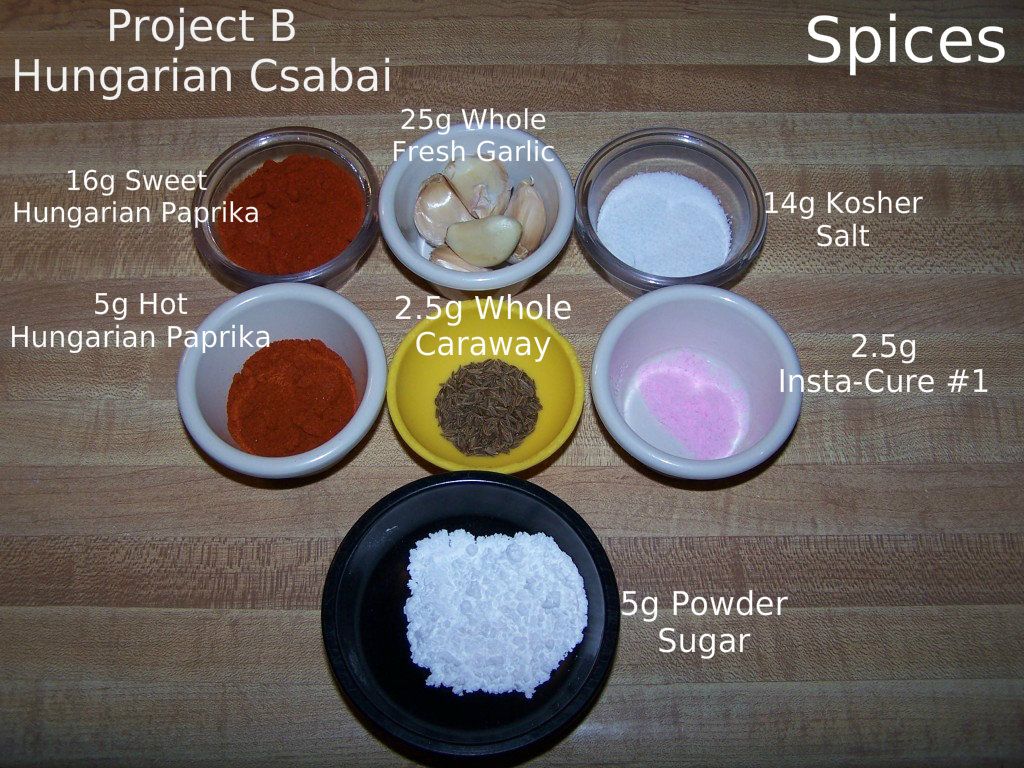
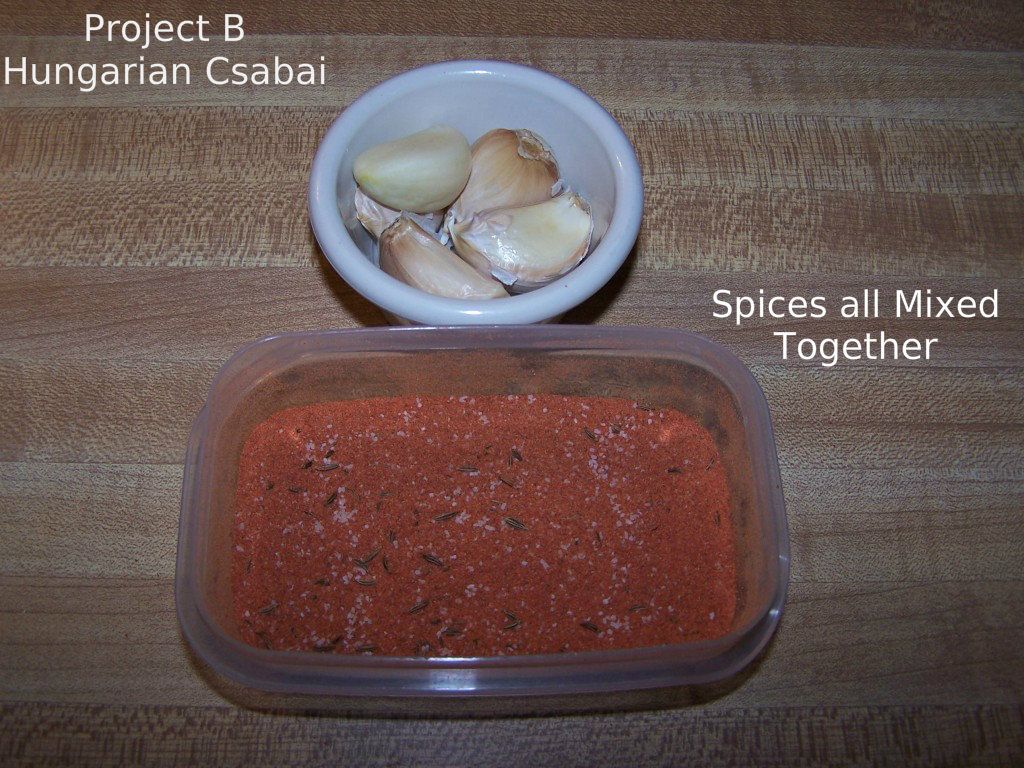
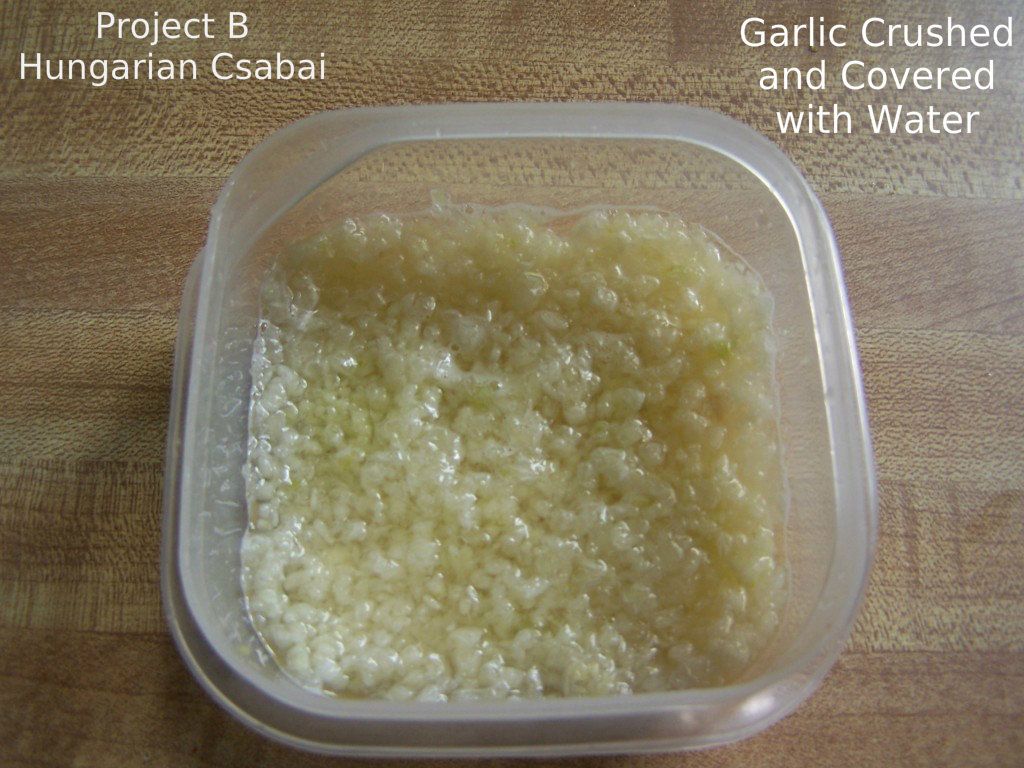
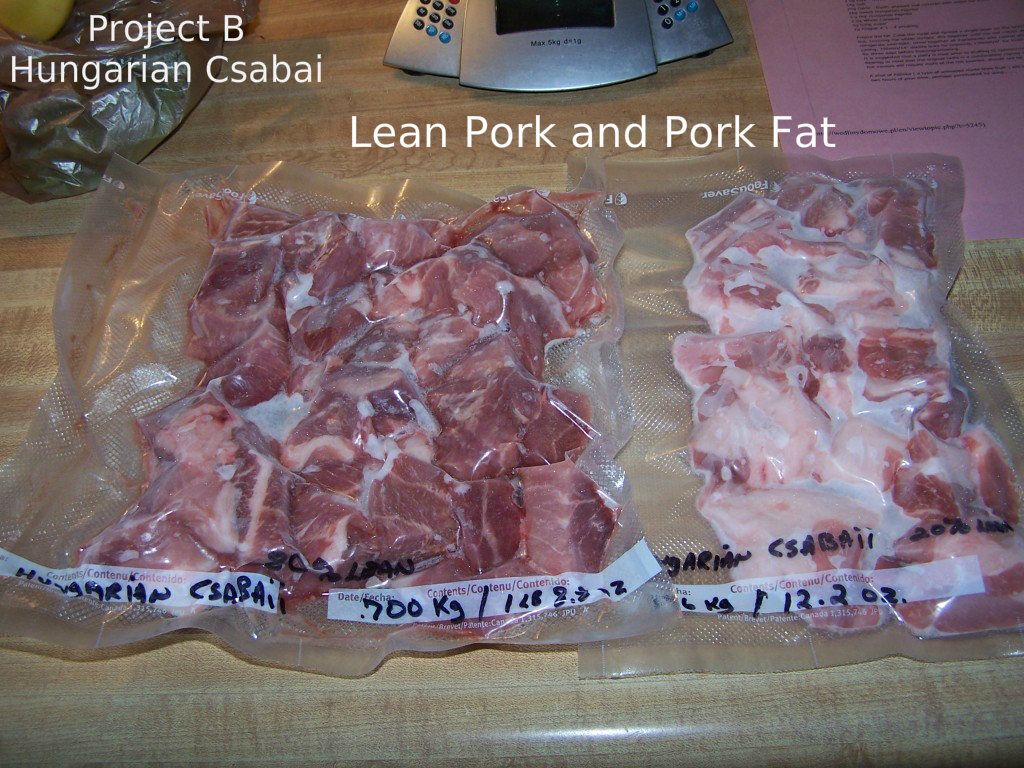


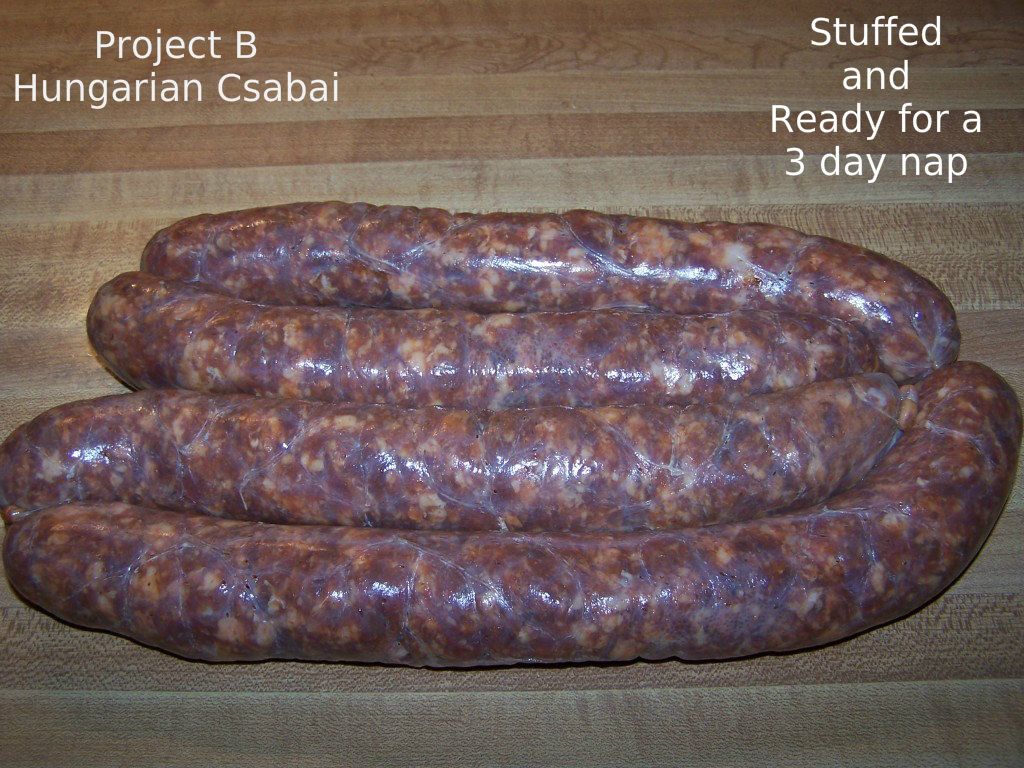
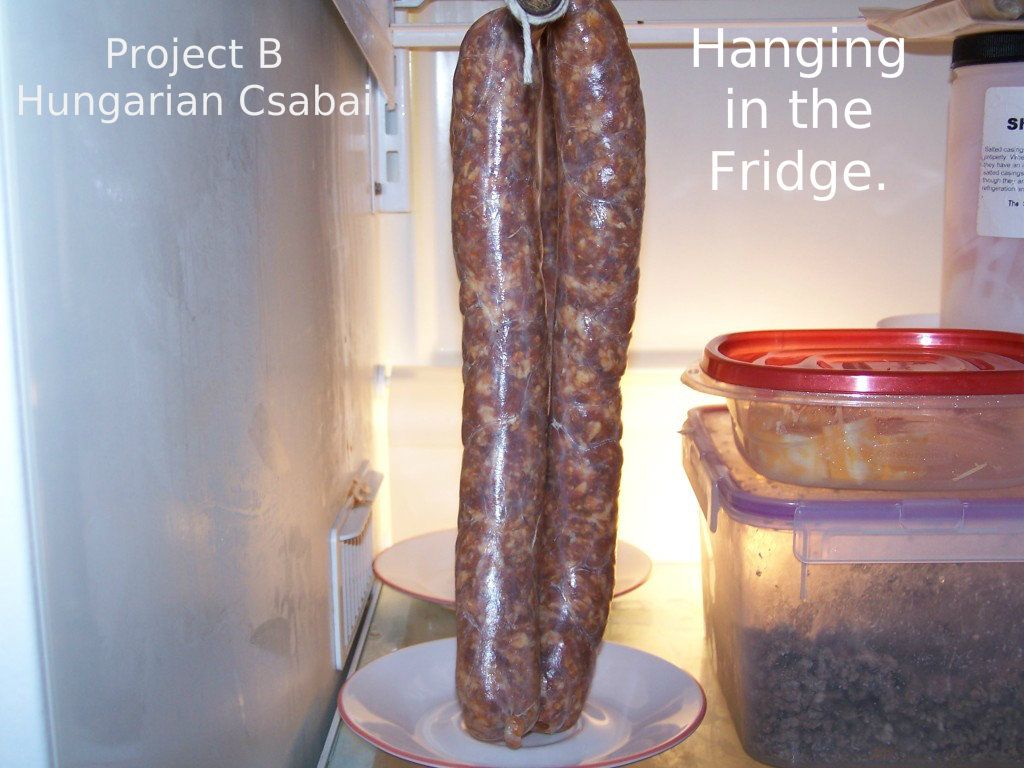
I love the smell of this Sausage and the color is very interesting can't wait to taste the finished product
John
Just got finished with making my Csabai and its now hanging in the fridge for a 3 day fridge nap as suggested prior to attempting to cold smoke it. Here are some pictures of the the process.








I love the smell of this Sausage and the color is very interesting can't wait to taste the finished product
John
Hi John,
Your csabai sausages look exactly like the ones I make. After blooming they will look even better.
Give it a decent smoking and they will become a work of art.
I have made already well over 50 kg of snagmans csabai and I will never get tired of eating them, fresh, smoked and/or dried. My small grandsons drive me nuts ringing me up asking for more of them all the time.
We are on a winner here.
Regards,
Jan.
Your csabai sausages look exactly like the ones I make. After blooming they will look even better.
Give it a decent smoking and they will become a work of art.
I have made already well over 50 kg of snagmans csabai and I will never get tired of eating them, fresh, smoked and/or dried. My small grandsons drive me nuts ringing me up asking for more of them all the time.
We are on a winner here.
Regards,
Jan.
Hi John.
Everything looks perfect.
The sausage, and the way you posted it too. I like to make it like that too, mix it together before grinding.
Now I declare you one of the kings of the real sausage makers. 5 stars.
And cold smoked it is the best.
******Some people grind all the caraway, and some people grind some of the caraway, that way a little more flavor is released. Some gets cut up at meat grinding.
Everything looks perfect.
The sausage, and the way you posted it too. I like to make it like that too, mix it together before grinding.
Now I declare you one of the kings of the real sausage makers. 5 stars.
And cold smoked it is the best.
******Some people grind all the caraway, and some people grind some of the caraway, that way a little more flavor is released. Some gets cut up at meat grinding.
Failure to prepare is preparing to fail.
- Chuckwagon
- Veteran

- Posts: 4494
- Joined: Tue Apr 06, 2010 04:51
- Location: Rocky Mountains
Okay sausagemakers,
I guess if we make csabai, we should be able to pronounce it right? Well, I set out on a mission to learn how to speak my only one known Hungarian word! So, I traversed the mountain and climbed to 14,000 feet to ask the Hungarian guru of sausage - you know, the 99 year old, bearded dude who keeps rollin' boulders down the canyon! Anyway, I was all out of breath when I looked up... only to find... El Duck-O! Yup, he was dressed in a Monk's hood and was makin' a fuss as usual. I could see his beak stickin' out of his hoodie. He wasn't foolin' anybody! So, I played along and said, "Oh wise one of the mountain, how do you pronounce csabai?"
"Keemosabe" he blurted out.
"Now listen here", I said, "I know that's not right". Grrrrr....
Grrrrr....
"Well", said the Duckster. "You asked me how"I" pronounced csabai."
I could plainly see that I would have to beat the stuffin' out of him, so I threatened him with some hostile gestures. Then, he blurted out the following:
"All together, now: shah-bah-eee-yeee. ...only, kinda swallow the last syllable, quickly. ...and the first syllable, you start like you were gonna say the letter "k", only you say "sh" instead."
Okay, did you get that cowboys? I've got to go sit down and practice it for an hour. Thanks Duck Dude!
Best Wishes,
Chuckwagon
I guess if we make csabai, we should be able to pronounce it right? Well, I set out on a mission to learn how to speak my only one known Hungarian word! So, I traversed the mountain and climbed to 14,000 feet to ask the Hungarian guru of sausage - you know, the 99 year old, bearded dude who keeps rollin' boulders down the canyon! Anyway, I was all out of breath when I looked up... only to find... El Duck-O! Yup, he was dressed in a Monk's hood and was makin' a fuss as usual. I could see his beak stickin' out of his hoodie. He wasn't foolin' anybody! So, I played along and said, "Oh wise one of the mountain, how do you pronounce csabai?"
"Keemosabe" he blurted out.
"Now listen here", I said, "I know that's not right".
"Well", said the Duckster. "You asked me how"I" pronounced csabai."
I could plainly see that I would have to beat the stuffin' out of him, so I threatened him with some hostile gestures. Then, he blurted out the following:
"All together, now: shah-bah-eee-yeee. ...only, kinda swallow the last syllable, quickly. ...and the first syllable, you start like you were gonna say the letter "k", only you say "sh" instead."
Okay, did you get that cowboys? I've got to go sit down and practice it for an hour. Thanks Duck Dude!
Best Wishes,
Chuckwagon
If it looks like a duck, walks like a duck, and quacks like a duck, it probably needs more time on the grill! 
- Chuckwagon
- Veteran

- Posts: 4494
- Joined: Tue Apr 06, 2010 04:51
- Location: Rocky Mountains
"Making Three Different Types Of Sausage From One Sausage Recipe."
"Mexican Chorizo"
Okay wranglers, let`s press on. For the next project, let`s examine (and make) three different types of sausage from the very same recipe. We`ve had a little experience now making great "fresh sausage" where there were no nitrate/nitrite cures used. It had to be refrigerated and used within three days or frozen for future use.
Next, we made a bit of "cured-smoked-cooked" sausage and added some sodium nitrite (Cure #1) to the ingredients. Our target was a residual nitric oxide of 156 parts per million. We saw that it indeed changed the texture and the flavor of the sausage. Some of us made a "cured loin" at this point and we called it, "Canadian Bacon". The photo by JBK of his Canadian Bacon (cured-smoked loin), will be burnt into my memory forever. That`s one of the best I`ve ever seen! We also learned that a "fresh" rear hog leg could be rubbed with nitrate/nitrite and it would become `ham`. If beef were rubbed (or injected and/or immersed in a saline solution), it eventually became "dried beef".
There`s a lot to be said about "prep-cooked and cured" sausages. Purchased in a supermarket, you may have to mortgage a kid, and even then, the product may be most disappointing. Prep-cooking "cured" sausage gives us the wonderful flavor and texture of the "Johnsonville Brat" - you know the stuff... weekend "brats" simmered in beer and roasted on the BBQ grill with plenty of smoke. But, why stop at brats? What about the Mexican "chorizo" sausage? It`s great fresh. It`s great "cured n` prep-cooked" for later grilling. Shucks, El Ducko`s chorizo is great smeared on the bumper of your `57 Chev!
Still... can we take it a step further and make a chorizo that we can slice cold and eat with a cold brew? Or, can we slice it like pepperoni and put it on a pizza to be cooked with the olives and green peppers atop the cheese? This is the "semi-dry-cured" sausage - a chorizo kicked up a notch by a process called "fermentation" - with which many of you are familiar. It will involve the use of a Bactoferm™ culture and you will see what flavor "controlled spoilage" of meat will produce. More importantly, you`ll understand "WHY" you are doing "WHAT" you are doing. Later, we`ll even make an encased "spreadable" German sausage with a medium-fast culture producing the "tangy" fermentation we`re looking for.
Right now, please re-read and understand the four basic types of sausages. Note that type #4 (air-dried or "dry-cured" sausage) requires an entire study all by itself! (See `Project A` in "Microbiology Of Meats"). Fully "dry-cured" sausage separates the men from the boys. This is where our pal Uwanna shines! That guy puts the commercial makers to shame. Following Project B, we`ll have a short rest then open another forum for crafting salami and pepperoni.
I know you`ve read this next information previously, but I`d like to ask you to re-read it as a review. Ask questions! That`s how we learn. If you don`t understand something, let us know. And remember, there are no silly questions here!
Basically, there are only four types of sausages:
Type 1. Fresh Sausage -"Fresh" sausage (meaning not cured), must be refrigerated and eaten within three days, or frozen for use later. Ol` timers know there is no such thing as a "secret recipe". There is however, "simply great sausage" - made using only salt, pepper, and only one or two other "signature ingredients". Add all the seasonings you wish; stuff it inside casings or mold it into patties; but use it within three days or freeze it, as it is not cured and not smoked. Refrigerate it at 38°F (3°C). This is the famous "breakfast" type sausage containing pork and sage. Other favorites include fresh Italian, fresh kielbasa, and of course... Mexican chorizo.
Important:
Fresh sausage is never smoked as the process cuts off oxygen, raising the risk of obligate anaerobic and microaerophile bacterial development, including clostridium botulinum!
Type 2. Cured, Cooked, And Smoked Sausage - This sausage is cured using sodium nitrite to destroy the toxin secretions produced by obligate anaerobic clostridium botulinum bacteria, as the oxygen is cut off when the meat is placed inside casings, and again as smoke replaces oxygen inside the smokehouse. Botulism, a potentially fatal illness causing flaccid paralysis, is the effect of food poisoning caused by clostridium botulinum. In 1925, the American Meat Institute introduced the use of sodium nitrite to America`s meat products. Since that time, there has not been a single case of food poisoning in this country due to botulism in commercially prepared cured meats. Sodium nitrite has also been found to prevent the growth of Listeria monocytogenes - the bacteria responsible for Listeriosis, a very virulent disease that can potentially result in the development of meningitis in newborns.
Following drying, cured-cooked-smoked sausages are prep-cooked (and smoked if desired) to destroy any possible trichinella spiralisand retain moisture. Finish cooking them on the grill or in a pan. These are the famous Bratwurst, Bockwurst, Knockwurst, and emulsified sausages known as hot dogs or "wieners". Also included in the emulsified category are bierwurst, Vienna sausage, and bologna. Cooked Italian mortadella, salami, Chinese "lop chong", Cajun boudin (blood) sausage, smoked Polish kielbasa, and German Berliner, are other popular favorites. Oh yes... let`s not forget our Mexican chorizo!
Type 3. Semi-Dry Cured Sausage - These are tangy, fermented, cured, sausages served on a fancy plate at a party or simply sliced with a pocketknife while you`re in the saddle. They are cured with nitrite (Cure #1), cooked during preparation, dried (yielding about 75%), but not usually further cooked before serving them. (An exception is pepperoni on pizza). Favorites include varieties of summer sausage, landjaeger, kabanosy, "slim jims", and yup... chorizo.
Type 4. Dry Cured Sausage - This is the only sausage that is not cooked during its preparation, and not usually cooked before serving or eating. Special precautions are taken with pork sausage in this category, as the destruction of possible trichinella spiralis becomes necessary. This is the only type sausage safe to eat without having been refrigerated and it is made with Cure #2 containing nitrate. Favorites include salamis from virtually every country, dry-cured Mexican chorizo, Italian sopressata, pepperoni, and other fermented sausages. A hygrometer, thermometer, fermentation chamber, and curing chamber, are necessary to produce dry cured sausages as well as a reasonable amount of sausage-making experience and a practical knowledge of the dry-curing procedure and a basic understanding of how bacteria affect the production of this type sausage. Oh yes, did I mention chorizo?
__________________________
First things first. Let`s begin by making a simple batch of El Ducko`s great chorizo. We`ll only make 2.2 lbs. (1 kg) and perhaps even freeze a link or two for later comparison. I`ve asked Russ to post his recipe now. Let`s get started smoke addicts! And don`t forget the "Yeeeee Haaaww"! Let`s make fresh chorizo!
********************
********************
Redzed, I apologize. The Duck has been waiting on me. I'd like everyone to make just 1 kg. (2.2 lbs.) of each type, then decide for yourselves which you like the best. I'd also like everyone to write just a sentence or two describing the difference in each.
He's been rarin' to go, while I've been dragging my feet. I'm trying to give everyone a little time to digest the fruits of their labors. Also, the expense of meat can be a little steep for some folks and it's just best not to rush things along right now.
There's an old saying in my country, "All good things cometh to he who waiteth, but he who waiteth just might haveth to waiteth like helleth!"
Best Wishes,
Chuckwagon
"Mexican Chorizo"
Okay wranglers, let`s press on. For the next project, let`s examine (and make) three different types of sausage from the very same recipe. We`ve had a little experience now making great "fresh sausage" where there were no nitrate/nitrite cures used. It had to be refrigerated and used within three days or frozen for future use.
Next, we made a bit of "cured-smoked-cooked" sausage and added some sodium nitrite (Cure #1) to the ingredients. Our target was a residual nitric oxide of 156 parts per million. We saw that it indeed changed the texture and the flavor of the sausage. Some of us made a "cured loin" at this point and we called it, "Canadian Bacon". The photo by JBK of his Canadian Bacon (cured-smoked loin), will be burnt into my memory forever. That`s one of the best I`ve ever seen! We also learned that a "fresh" rear hog leg could be rubbed with nitrate/nitrite and it would become `ham`. If beef were rubbed (or injected and/or immersed in a saline solution), it eventually became "dried beef".
There`s a lot to be said about "prep-cooked and cured" sausages. Purchased in a supermarket, you may have to mortgage a kid, and even then, the product may be most disappointing. Prep-cooking "cured" sausage gives us the wonderful flavor and texture of the "Johnsonville Brat" - you know the stuff... weekend "brats" simmered in beer and roasted on the BBQ grill with plenty of smoke. But, why stop at brats? What about the Mexican "chorizo" sausage? It`s great fresh. It`s great "cured n` prep-cooked" for later grilling. Shucks, El Ducko`s chorizo is great smeared on the bumper of your `57 Chev!
Still... can we take it a step further and make a chorizo that we can slice cold and eat with a cold brew? Or, can we slice it like pepperoni and put it on a pizza to be cooked with the olives and green peppers atop the cheese? This is the "semi-dry-cured" sausage - a chorizo kicked up a notch by a process called "fermentation" - with which many of you are familiar. It will involve the use of a Bactoferm™ culture and you will see what flavor "controlled spoilage" of meat will produce. More importantly, you`ll understand "WHY" you are doing "WHAT" you are doing. Later, we`ll even make an encased "spreadable" German sausage with a medium-fast culture producing the "tangy" fermentation we`re looking for.
Right now, please re-read and understand the four basic types of sausages. Note that type #4 (air-dried or "dry-cured" sausage) requires an entire study all by itself! (See `Project A` in "Microbiology Of Meats"). Fully "dry-cured" sausage separates the men from the boys. This is where our pal Uwanna shines! That guy puts the commercial makers to shame. Following Project B, we`ll have a short rest then open another forum for crafting salami and pepperoni.
I know you`ve read this next information previously, but I`d like to ask you to re-read it as a review. Ask questions! That`s how we learn. If you don`t understand something, let us know. And remember, there are no silly questions here!
Basically, there are only four types of sausages:
Type 1. Fresh Sausage -"Fresh" sausage (meaning not cured), must be refrigerated and eaten within three days, or frozen for use later. Ol` timers know there is no such thing as a "secret recipe". There is however, "simply great sausage" - made using only salt, pepper, and only one or two other "signature ingredients". Add all the seasonings you wish; stuff it inside casings or mold it into patties; but use it within three days or freeze it, as it is not cured and not smoked. Refrigerate it at 38°F (3°C). This is the famous "breakfast" type sausage containing pork and sage. Other favorites include fresh Italian, fresh kielbasa, and of course... Mexican chorizo.
Important:
Fresh sausage is never smoked as the process cuts off oxygen, raising the risk of obligate anaerobic and microaerophile bacterial development, including clostridium botulinum!
Type 2. Cured, Cooked, And Smoked Sausage - This sausage is cured using sodium nitrite to destroy the toxin secretions produced by obligate anaerobic clostridium botulinum bacteria, as the oxygen is cut off when the meat is placed inside casings, and again as smoke replaces oxygen inside the smokehouse. Botulism, a potentially fatal illness causing flaccid paralysis, is the effect of food poisoning caused by clostridium botulinum. In 1925, the American Meat Institute introduced the use of sodium nitrite to America`s meat products. Since that time, there has not been a single case of food poisoning in this country due to botulism in commercially prepared cured meats. Sodium nitrite has also been found to prevent the growth of Listeria monocytogenes - the bacteria responsible for Listeriosis, a very virulent disease that can potentially result in the development of meningitis in newborns.
Following drying, cured-cooked-smoked sausages are prep-cooked (and smoked if desired) to destroy any possible trichinella spiralisand retain moisture. Finish cooking them on the grill or in a pan. These are the famous Bratwurst, Bockwurst, Knockwurst, and emulsified sausages known as hot dogs or "wieners". Also included in the emulsified category are bierwurst, Vienna sausage, and bologna. Cooked Italian mortadella, salami, Chinese "lop chong", Cajun boudin (blood) sausage, smoked Polish kielbasa, and German Berliner, are other popular favorites. Oh yes... let`s not forget our Mexican chorizo!
Type 3. Semi-Dry Cured Sausage - These are tangy, fermented, cured, sausages served on a fancy plate at a party or simply sliced with a pocketknife while you`re in the saddle. They are cured with nitrite (Cure #1), cooked during preparation, dried (yielding about 75%), but not usually further cooked before serving them. (An exception is pepperoni on pizza). Favorites include varieties of summer sausage, landjaeger, kabanosy, "slim jims", and yup... chorizo.
Type 4. Dry Cured Sausage - This is the only sausage that is not cooked during its preparation, and not usually cooked before serving or eating. Special precautions are taken with pork sausage in this category, as the destruction of possible trichinella spiralis becomes necessary. This is the only type sausage safe to eat without having been refrigerated and it is made with Cure #2 containing nitrate. Favorites include salamis from virtually every country, dry-cured Mexican chorizo, Italian sopressata, pepperoni, and other fermented sausages. A hygrometer, thermometer, fermentation chamber, and curing chamber, are necessary to produce dry cured sausages as well as a reasonable amount of sausage-making experience and a practical knowledge of the dry-curing procedure and a basic understanding of how bacteria affect the production of this type sausage. Oh yes, did I mention chorizo?
__________________________
First things first. Let`s begin by making a simple batch of El Ducko`s great chorizo. We`ll only make 2.2 lbs. (1 kg) and perhaps even freeze a link or two for later comparison. I`ve asked Russ to post his recipe now. Let`s get started smoke addicts! And don`t forget the "Yeeeee Haaaww"! Let`s make fresh chorizo!
********************
********************
Redzed, I apologize. The Duck has been waiting on me. I'd like everyone to make just 1 kg. (2.2 lbs.) of each type, then decide for yourselves which you like the best. I'd also like everyone to write just a sentence or two describing the difference in each.
He's been rarin' to go, while I've been dragging my feet. I'm trying to give everyone a little time to digest the fruits of their labors. Also, the expense of meat can be a little steep for some folks and it's just best not to rush things along right now.
There's an old saying in my country, "All good things cometh to he who waiteth, but he who waiteth just might haveth to waiteth like helleth!"
Best Wishes,
Chuckwagon
Last edited by Chuckwagon on Fri Oct 05, 2012 22:46, edited 2 times in total.
If it looks like a duck, walks like a duck, and quacks like a duck, it probably needs more time on the grill! 






